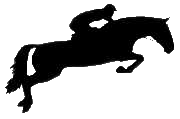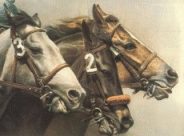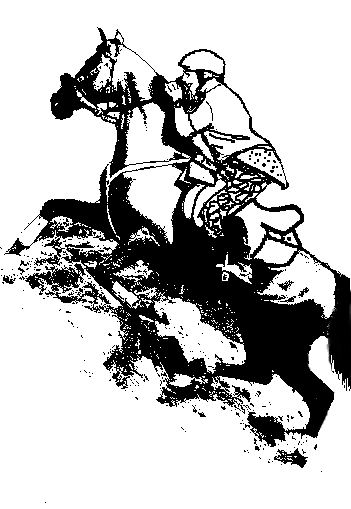 Riding Styles
Riding Styles 

 Riding Styles
Riding Styles 

Eventing
Show Jumping
Racing
Polo
Long Distance
Eventing
Like so much of our equestrian heritage, eventing, or horse trials, have their origins in the military practice of using competitions to test the endurance, speed and obedience of the horse, as well as the ability of the rider. In French, eventing is "concours complet" - the complete test - and it was France that held the Championat du Cheval d'Armes in Paris in 1902. This competition comprised of a dressage test, a steeplechase, a 30 mile race over roads and tracks and, finally, a jumping test.
The first Olympic three-day event was restricted to military riders. It was held at the Stockholm Games in 1912 and was won by the host nation.
Civilians were allowed to compete after the Second World War, and from that point the sport developed dramatically. The greatest factor in the encouragement of eventing as a sport was the establishment of the Badminton Horse Trials on the Duke of Beaufort's estate in Gloucestershire in 1949.
Horse trials are based on a qualifying progression, beginning with novice one-day events and culminating in the full three-day event, horses being graded according to performance records.
In the three-day event, the dressage phase takes place first. The second day is the speed and endurance phase, which covers about 16 miles and is central to the competition. This phase begins with a section of roads and tracks that leads to the steeplechase course. Following the steeplechase, there are more roads and tracks before the cross-country course.
The steeplechase is 2 miles, and the cross-country is 4 1/2 miles and 32 fences. Many of the fences are combinations so, in fact, the horse makes well over 32 jumps. The whole adds up to about 1 1/2 hourse of effort. On the final day there is a veterinary inspection and a show jumping test, to prove the horse is "fit for further service".
Show Jumping
Until the end of the nineteenth century, jumping was not a feature of the equestrian world. The first jumping competitions were tests for hunters. The Royal Dublin Society staged a high and wide "leaping" competition on Leinster Lawn, Dublin, in 1865, and that is the first record of an organized competition. A year later, a jumping class was included at the Paris Show, but this was a cross-country event.
In 1900, in Paris, jumping competitions were held as part of the Olympic Games. There were three competitions: a timed "prize jumping", won by Haegeman of Belgium; a long jump won by his compatriot van Langendonk; and a high jump won by Gardieres of France, who cleard 6ft.
Additional impetus was given to the sport by the inauguration of the Internation Horse Show at Olympia, London in 1907. It was a splendid extravaganza that was to become the backbone of the sport in the years between the World Wars, and was to stage the first National Cup competition.
The rules took some time to develop and, at first, were very complex. Britain and America used slats, or slip fillets, in their national fules until after the Second World War. The slats rested on the top of the fence and penalties were given if they were dislodged. The system was further complicated by a distinction between knockdowns made with either fore or hind legs. The time taken to complete the course was not considered important, and judging was imprecise.
However, after the Second World War the rules were formulated on an international basis. Time became an integral factor and added much to the excitement of a competition. The clarity of the new rules allowed a greater degree of participation on the part of the onlooker, making it easy to follow the competition.
Today, courses are built with accuracy and artistry to test the ability of both horse and rider. Some of the principal factors involved are: the size and type of the fences built, the number of strides in combination fences, and the time allowed to complete the course.
The principal international shows, judged under the rules of the Federation Equestre Internationale (FEI) are the Olympic Games, held every four years; the World Championships held in the even years between the Olympic Games; and the World Cup, a series of indoor competitions run in regional leagues and culminating in a final. There are also european and American championships and the Nations Cup competitions, which are staged each year by participating nations. The President's Cup is awarded to the country that scores the most points in the year's Nations Cup competitions.
Racing
If only because mankind is very competitive, it is certain that the matching of one horse against another began early in the history of equine domestication. In the Ancient World, chariot racing precede ridden races by centuries, and was always more popular. The first recorded, ridden race was at the Greek Olympiad in 624B.C.
Modern racing, particularly on the flat or over fences, and harness racing, to some degree, owes its existence to the Thoroughbred: the "superhorse" that was developed in Britain during the seventeenth and eighteenth centuries. Racing in Britain has traditionally enjoyed Royal patronage, hence its title the "Sport of Kings". James I was an enthusiast who put the town of Newmarket on the map as the headquarters of racing. After the Restoration, Charles II continued developing the sport at Newmarket and, with the encouragement of Queen Anne, the Ascot racecourse, the most fashionable of British courses, was laid out in 1711. The Jockey Club, racing's governing body, was founded in about 1752.
Britain operates the Pattern racing system, which is a series of races set over appropriate distances to provide proper tests for the best horses of all ages, including Group One championships. Group One includes the Classics for 3 year olds. These are the Derby and the Oaks, held at Epsom; the 2,000 Guineas, and the corresponding race for fillies, the 1,000 Guineas, both run at Newmarket; and the Doncaster St. Leger. The Derby (first run in 1780), the 2,000 Guineas (1809) and the St. Leger (1776) constitute the European "Triple Crown". This is the ultimate accolade of the Turf and has only been won by twelve horses since its inauguration in 1853.
Racing all over the world follows the British pattern. The most influential racing nations in Europe, other than Britain and Eire, are France and Italy. In Italy, Federico Tesio's Dormello Stud has bred many successful race horses, including Donatello II, Nearco and Ribot. Racing thrives in both Australia and New Zealand, but the greatest influence is exerted by the multimillion dollar industry in the United States.
The first American racetrack was laid out on Long Island in 1664 by Richard Nicolls, the first governor of New York. It was near the site of the present Belmont Park. Today, the center of the American Thoroughbred is the 2,500 square miles of Blue Grass country in Kentucky. The Kentucky Derby, run at Churchill Downs in Louisville, was founded in 1875. The American Triple Crown consists of this race, the Preakness Stakes and the Belmont Stakes.
Steeplechasing takes place on a small scale in Europe and America, but its home is in Britain and Ireland where it is enormously popular. The first recorded match, and the one that gave the sport its name, took place in Ireland when Messrs. O'Callaghan and Blake raced their hunters over the 4 1/2 miles separating Buttevant Church from St. Leger Church - from steeple to steeple.
The most famous of the English steeplechases is the Grand National, which has been held in April at Aintree since 1837. There are 30 fences on the course, and it is unique among jumping races. Nonetheless, Cheltenham is generally regarded as the center of steeplechasing, and its Gold Cup is recognized as the jewel in the crown of British steeplechasing.
The big race in continental Europe is Czechoslovakia's Gran Pardubice. This is similar to a cross-country race and incorporates numerous natural hazards. America's best known jumping race is the Maryland Hunt Cup, which is run in open country over post and rail fences.
America is the world's leading harness racing nation. Upward of 30 million spectators attend the floodlit evening meetings at raceways like Meadowlands in New Jersey, Roosevelt on Long Island and the Red Mile at Lexington.
Polo
Polo, played almost entirely at the gallop, is the fastest game in the world. A form of polo was played in Persia and China about 2,500 years ago by both men and women. It was called changar, meaning mallet in Persian, but the word polo is from the Tibetan word for a ball, pulu. British soldiers and civilians serving in India during the nineteenth century were responsible for bringing polo to the West. The British played on 12.2hh ponies in the state of Manipur, between Assam and Burma, where it was the national game.
The first recorded game in Britain took place in 1869 when officers of the 10th Hussars at Aldershot played what was described as "hockey on horseback". Polo was introduced to America in 1878 by the newspaper tycoon James Gordon Bennett, Jr. He was inspired by a visit he had paid to Hurlingham (later the headquarters of British polo) two years previously.
The Americans quickly established a formidable supremacy with their superbly drilled and mounted teams. The Anglo-American Westchester Trophy was first played in 1886 with teams reduced to four players a side. The Americans did not win this trophy until 1909, but thereafter they proved unbeatable.
Polo was first played in Argentina in 1877 and by the 1930s Argentina had become the world's leading polo nation.
Polo "ponies" may be of any height. The teams comprise four players and there are usually two mounted umpires. A polo field measures 300yd X 200yd. It is marked with a center line and penalty lines at 30yd, 40yd and 60yd from each back line. The object is to score goals by hitting the willow ball through goalposts 10ft high and 24ft apart, while traveling, usually at full speed. When a goal is scored, the teams change ends.
Players are handicapped according to ability. High goal polo is when the total team handicap is around 19 goals; a medium goal game is between 15 and 18 goals. A match is divided into chukkas of 7 1/2 minute durations. There are five or six chukkas in a high-goal match, four at smaller events. The ponies are changed after each chukka and no pony plays more than two chukkas in a match. Penalties are given for such faults as crossing a player's line dangerously and bumping. However, it is permitted to ride an opponent off the ball or to hook his stick.
Long Distance
Distance riding can be divided in general terms between competitive trail rides and endurance events. The endurance events are races, the winner being the first horse past the post that also passes the stringent veterinary checks, a feature of the modern sport. Endurance rides may cover between 25 and 100 miles in one day; or there are divided rides in which the 100 miles is covered in two days.
Competitive trail events are ridden over a set distance at a stated speed, such as 30 miles at a speed of 7-8mph. Veterinary checks are included as in the endurance rides.
The first one-man one-horse rides, the forerunners of the modern sport, were held in the 1890s and early 1900s as cavalry tests, particularly by the mounted forces of Germany and the Austro-Hungarian Empire. They were designed to improve riding and fitness standards, but often turned out to be events in which horses were ridden to death. The organizers of the 1903 Paris-Deauville ride attempted to put matters right by imposing speed restrictions. However, the sport has its true foundations in the supervised rides that were first held by the American calvary.
America remains the world leader in endurance riding. The Americans base the sport on the innovative Vermont 100-Mile, held in 1936. This three-day ride adhered to the strict regulations formulated for the cavalry tests.
Over 500 rides are held in the US each year, including the famous 100-Mile Western States Ride, known as the Tevis Cup Ride. This is probably the toughest endurance test of horse and rider of them all. First held in 1955, the course runs from Tahoe City, Nevada, to Auburn, California, over the steep Sierra Nevadas. Despite the formidable terrain and the awesome 9,500ft climb through the El Dorado Canyon, where temperatures can reach 100 degrees, the distance is usually covered by the leaders in 11 to 12 hours.
The Australian equivalent of the Tevis Cup Ride is the Tom Quilty Ride. This is held annually over the same distance. The event is very demanding and places just as great a premium on fitness and skillful horse-management, factors that are an integral part of the sport.
In Britain, the sport was pioneered by the Arab Horse Society, which held endurance rides between the World Wars. Arabian horses, part- and purebred, still dominate the distance riding event all over the world. The Society still stages an annual marathon over the classic 26 1/4 miles which, although it includes a walk section, is a race with competitors often riding to the finish line.
The British Open Endurance Riding Championships is the 100-mile Summer Solstice Ride held by the Endurance Horse and Pony Society. The other British society that organizes distance rides is the Long Distance Riding Group - part of the British Horse Society. This group runs two 100-mile rides and the well-known Golden Horseshoe final, over 100 miles of rugged Exmoor country. The Golden Horseshoe final is not a race. Gold medals are awarded to all who pass the veterinary checks and complete the course at not less than 8mph.
Reference: The Ultimate Horse Book, Elwyn Hartley Edwards, 1991


Most harness races are for pacers, with the legs moving in lateral rather than diagonal pairs, but there are also races for conventional trotters. Races are usually set over one mile, and times of 1.54 minutes or less are not unusual.


This
Hunter/Jumper site is maintained by The White Arabian
[Previous]

[Next Site]
[Skip Previous]
[Skip Next]
